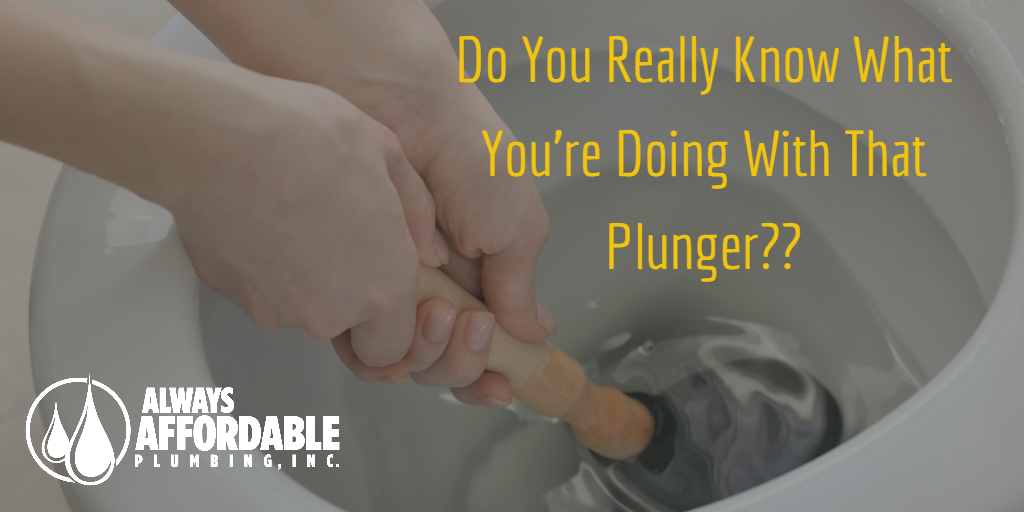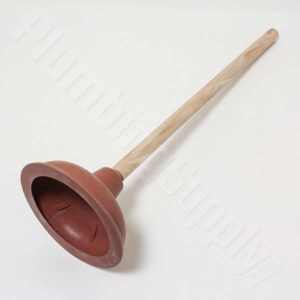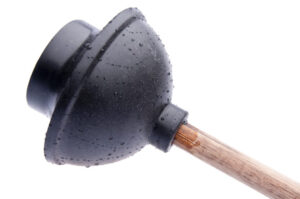
27 Apr Best Fairfield Plumber Tips: How to Use a Plunger Like a Pro!
Best Fairfield Plumber | How to Use a Plunger
Using a Plunger Properly Might Help Avoid an Emergency Call to a Plumber
A plunger is one of a Plumber’s go to tools. Most households own a plunger already. This is simply because they are affordable and simple. However, do you really know how to use a plunger properly? Do you even have the right plunger for the job? Our Best Fairfield Plumber Tips today give you a little insight into plungers and how to use one properly.
How Does a Plunger Even Work?
Let’s start here. A plunger is used to clear a clogged drain. That could be a sink or a toilet, although most people think of just toilets when it comes to plungers. Another popular misconception is that plungers work by pushing the clogged material down the drain. That is not entirely accurate. A plunger actually works by moving water back and forth forcefully, until the clogged material is dislodged. Once it is dislodged it can finally move down the drain. In order to move water back and forth, the plunger must first create suction. This is an important part of using a plunger correctly. With proper suction, the vigorous up and down movement of the plunger whooshes the standing water back and forth forcefully, and presto! Your drain is clear.
Why Are There Different Types of Plungers?

A Standard Plunger
There are a couple of different designs for plungers so that they can work better for different types of clogged drains. The standard plunger that most people are familiar with looks like a rubber ball cut in half, sitting at the end of a stick. This is a standard plunger and will cost you only about $3 or so. It is best suited to be used on clearing sinks and floor drains (like in a shower).
If you want to clear a toilet clog, then you should choose the right plunger though. A standard plunger can work, but is a little more difficult to use properly in a toilet. For a toilet, we would recommend a “flange” plunger. This type of plunger has a large rubber flange on the bottom. This flange is designed to help create a better seal in the curved drain of a toilet bowl. As we mentioned above, a plunger works because of suction, and you can’t have good suction without a good seal. A flanged plunger will cost you somewhere around $10-$15. While it is quite a bit more expensive than a standard plunger, it is a worthwhile investment. You can also use a flanged plunger on a sink by tucking the flange up into the “bell” of the plunger.
You may see other types of plungers out there. For the most part, we would consider these novelties. They certainly are not any more effective than a traditional, flanged plunger, if they even work at all. This can include accordion style plungers, push-button, as well as a strange disposable plastic sheet you wrap over the top of the toilet bowl. Don’t waste your money on these.

A Flanged Plunger
How to Use a Plunger Properly
OK let’s say you have a clogged toilet. Before you call Always Affordable Plumbing, let’s give a plunger a try. (Don’t own a plunger but have a clogged toilet? TRY THIS)
-
turn the water off to the toilet
As soon as your toilet does not clear a flush, turn off the water valve to prevent an overflow!
-
put on dish gloves or rubber gloves
You are dealing with potentially dirty water here, so let’s stay clean and keep any splashes off of us!
-
put a few towels down around the base of the toilet
This will help control any mess from water splashing or overflowing.
-
if water has filled up to the brim, give it about 3-5 mins to see if the water can drain down a bit
As soon as you put the plunger in a full toilet, the water will overflow. Yuck! While the toilet drain might be too clogged to flush, water might still be able to slowly seep past. Give it a few minutes to see. You don’t need the toilet bowl empty, just not brimming to the top. If it doesn’t drain down at all, you should scoop water out using a disposable cup, and pour the water down the sink or tub.
-
plug the drains of the sink and tub in the bathroom
All of your plumbing is connected, so plugging the other drains in the bathroom can help improve suction. This step is not critical, but it can be helpful.
- put the flange of the plunger into the drain hole, so that the rubber lip can create a tight seal around the drain opening
Proper positioning will ensure the best suction.
-
your plunger handle should be straight up and down, not at an angle
You might think you need to angle the plunger to get a seal, but the best seal will actually be from being straight up from the drain hole.
-
forcefully depress the plunger up and down for at least 10 seconds
If you have a proper seal, this should not cause water to splash. The suction from the plunger will cause the water stuck in the pipes to whoosh back and forth as you “plunge”, eventually dislodging the clog. This takes a little “elbow grease”, so to speak, so don’t get discouraged if it doesn’t clear right away. After about 10 to 20 seconds of vigorous plunging, lift the plunger up from the drain hole. Keep the plunger within the toilet bowl since it will be dripping wet. If the clog was moved, any water in the toilet bowl should drain out right away. Congrats! But now you need to test it for sure.
How to Test if You Cleared Your Toilet Clog
To make sure your toilet clog has been cleared you will need to do a test flush. Set your plunger aside…keep in mind that it is not sanitary at this point, covered in dirty toilet water. Best to set it in the tub (if you have one) or on one of the towels you had set down already.
- turn the water fill valve for the toilet back on
- let the toilet tank fill completely
- once full, FLUSH
- BE PREPARED TO SHUT THE WATER OFF if the toilet water starts to rise, indicating that it is still clogged
If it doesn’t flush, don’t be discouraged. Some clogs are stingy. Simply get your plunger out and give it another go. If it does flush, then you did it! Let the tank fill again and flush it once more for good measure. Wash your plunger off in the tub or sink and let dry.
What if Plunging Didn’t Work?
OK so worse case scenario, plunging just didn’t bust the clog. Don’t waste more time, because if after a couple go’s it didn’t work, the problem requires a little more help. At this point you will want to call Always Affordable Plumbing Solano and Sacramento. When a plunger can’t clear a clogged drain or toilet, it is usually because there is a significant blockage further down the drain. Plungers and drain cleaners likely won’t be effective for this type of clogged drain.
A professional plumber will come out and assess the situation. Most likely, for a stubborn toilet clog, we would utilize a special type of auger designed for toilets. Unlike a standard auger (or “snake”), these ones won’t damage the porcelain of your toilet. The auger is run deep into the drain line and then the tip spins around, breaking up build up, gunk, and blockages.
WANT A FREE HOME PLUMBING INSPECTION?? JOIN OUR DISCOUNT PLUMBING MEMBERSHIP PROGRAM!!!
Service, quality, and affordability for our customers always comes first. Call today to schedule your appointment!
For our great plumbing tips and updates, FOLLOW US ON FACEBOOK!
CLICK HERE to learn about EASY WATER HEATER MAINTENANCE to save you money!
Find out more about Always Affordable Plumbing (Lic. #1003782) by calling:
SACRAMENTO VALLEY: (916) 970-0188
SOLANO COUNTY: (707) 410-3182
Best Fairfield Plumber | How to Use a Plunger


